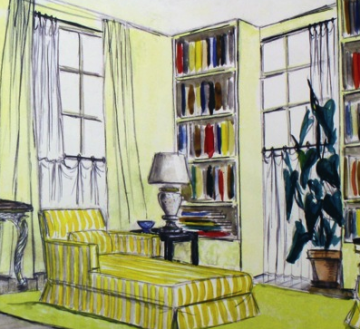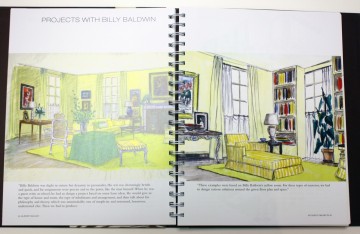Before adjourning our afternoon with Albert Hadley, we asked him what words or advice he would share with a new designer today, given the current economic and social climate. His spectacular advice was prefaced with his thoughts on how design has changed since he entered the arena and the many challenges that follow such changes.
"It's very interesting, I think that the normal change we all recognize in society and in the world influences not only the design world, which has been influenced all the way through, but the world as we know it. The design world has changed enormously, especially in the last few years. Until recently, everything was done as I have described it—by carrier, by seeing, by personal involvement. Today, the fact that one can go online and learn everything about everything, shop without seeing, and be involved without being involved has made a big difference in society and the way people live. People don't live today the way they used to and money has nothing to do with it.

"I was thinking about it the other day, and one of the great things that's missing in our society today is one person and one book. That person was Emily Post and that book was Etiquette. Her book of etiquette was a bible for society up until a fairly short time ago and Mrs. Post was thought of as the arbiter of not only good taste, but also civilized living. It is a document that civilized people in this country and in others followed, even for the simplest things like how to write a 'thank-you' note to be sure you were doing it properly. It made life more attractive and more substantial. I think the fact that there was something to base yourself on was very important. That's gone now; it'll never come back. We now seem to have everything we need to go beyond what we know and continue it."
Albert said that society's changes have had an enormous impact on interior design and have made a big difference in the attitude of designers, especially those just starting out.
"It might be said that a lot of young designers don't have the background that young designers were required to have when I began. I believe that if you're going to be a creative person and if you're working with people, the more you know about the history of design and this art, the better off you are. These subjects must be known because where we are today is a reflection of where we've been. I don't think it's enough to acknowledge it and forget it because I don't think we're ever going to completely forget it. At least we hope! We hope there's more to it than that."

"I've always encouraged the young people I've worked with or any creative person I've come across to be open to things that are stimulating to the imagination," Albert continued. "A lot of it has to do with being visual. Whether you're impressed by the art on the wall—whether you like it or not—there it is and you acknowledge it and think about it and feel something because of it. For a young person who's in this world, the more she knows about what other people are creating, the more she is going to develop."
Albert slid his book Albert Hadley: Drawings and the Design Process in front of us and opened it to several of his sketches—the seeds of thought that would later grow into the interiors of some of the most prominent people in the world.
"It's like when this book was put out, the director of the New York School of Interior Design had seen some of my sketches and asked if she could borrow some because she wanted the students to see my process," Albert explained, pointing out both black and white sketches and colorful, detailed drawings alike. "I generally don't project these because I don't consider these fine art. They are short-hand from my imagination, they are sketches that are created to help develop an idea."

Albert points to a drawing of his with latticework climbing up two walls of a room. "You can see that I've thought I might like the idea of some sort of lattice work but before that happens, it's going to be developed on paper further and it's going to improve or evolve. Every sketch in here was in the process of growing—it might have been very rough or in the middle or just a note of where I'd been or what I'd seen but you can't do this on a computer. You cannot design on a computer. So that's what NYSID's director wanted to show the students, and I'm told that it was very helpful to them. Some of those students approached me to tell me how much it meant to them that they were learning to draw for the first time. They had always seemed to feel that they couldn't draw! I told them that all they needed to do was put pencil to paper and have a thought!"
Albert Hadley is the DDB's Stars of Design chosen recipient for the Lifetime Achievement award. To purchase a copy of Albert Hadley: Drawings and the Design Processor Albert Hadley: The Story of America’s Preeminent Interior Designer visit Potterton Books.

No comments:
Post a Comment